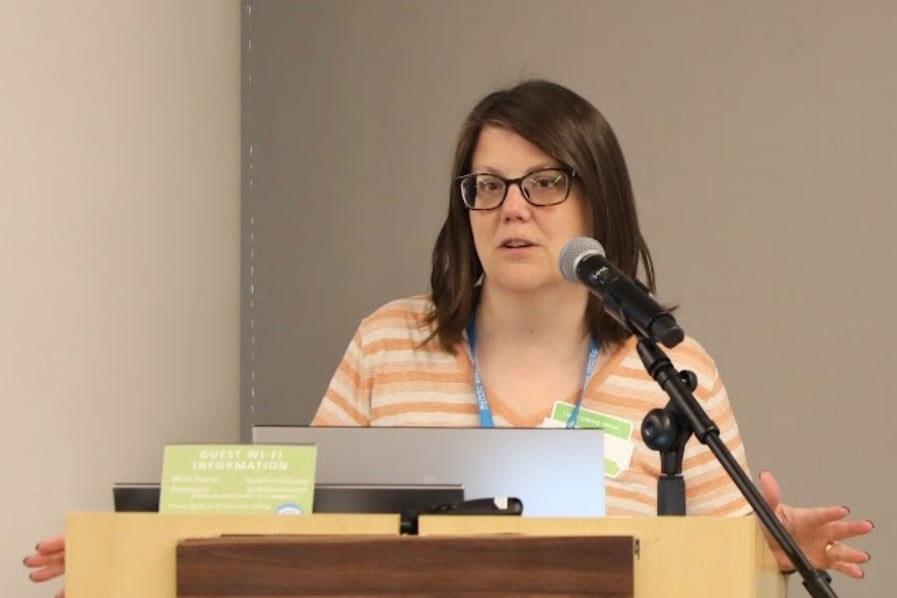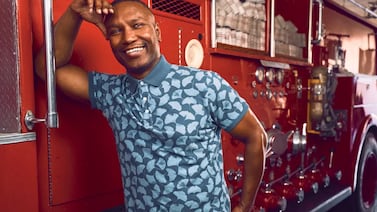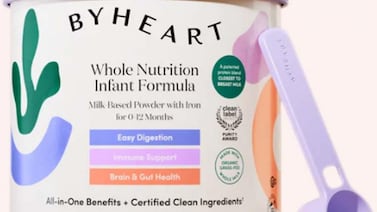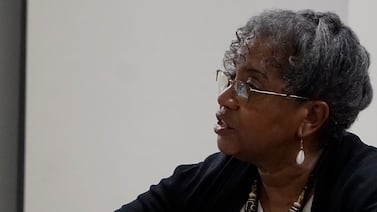Public health, explained: Sign up to receive Healthbeat’s free Atlanta newsletter here.
Karen Ernst is the director of Voices for Vaccines, a national organization focused on increasing vaccination rates by providing accurate information to families. The organization is part of the Task Force for Global Health in Atlanta.
Ernst, who lives in Minnesota but often travels to Atlanta, is a former English teacher who became a public health leader focused on “bringing people to this place of calm and good information, and helping to protect as many families and communities as possible.” Ernst was featured in the documentary Shot in the Arm, which aired on PBS and was executive produced by Neil deGrasse Tyson.
In Georgia, and nationally, childhood vaccination rates are decreasing, according to data recently released by the Centers for Disease Control and Prevention. Georgia has reported six measles cases in unvaccinated people this year. Some vaccine hesitancy is driven by misinformation on social media, research shows. Vaccines are safe and help save lives, scientists and doctors emphasize.
Turning down the temperature on heated conversations on vaccines is part of Ernst’s approach, and her own questions and anxieties around vaccines when she was a new parent inform her empathetic approach to those conversations.
Here are some of her thoughts about improving communication around vaccines.
How has the dialogue around vaccines changed since you started with Voices for Vaccines in 2012?
What we’re seeing right now is people really feeling less engaged in their communities in general. This is systemic beyond vaccines. I call it the age of disengagement, people really disengaged themselves from each other. They’re not as involved in their communities, they don’t know their neighbors, they don’t trust their public servants, they don’t trust scientists who seem very far away. And all of this disengagement has made it a lot more difficult to empower people with information and to get people to trust that vaccines are going to do something good for their family.
I’ve seen people cornering themselves into their own sphere and have trouble feeling trust. And trust is really engagement, that they are involved in their communities, that they’re involved with their neighbors, that they have a stake in people’s lives, that they have a stake in, and a say in, what the government is doing, and what their local public health officials are doing, and what science is happening. That’s the biggest change I’ve seen. And as I said, it makes it more difficult to engage people, even to even start those conversations. It’s gotten trickier.
What is the role of social media in the conversation around vaccines?
When I started in 2012, I was already alarmed about social media, and I used to describe those days as the wild west, because you could literally say anything on social media. There were no guardrails. We’ve taken the guardrails away again. Certainly, social media does two things: It amplifies rumors, it amplifies scary stories that are hard to verify, but it also has what I call a pufferfish effect. It makes vaccine hesitancy seem a lot more common than it is. It makes ideas about vaccines seem more prevalent than they are, because it’s easier to find someone who will think the same thing as you.
If we had some guardrails, if we had better engagement in the physical world of our communities, social media wouldn’t be as much of a factor in driving false information about vaccines.
It’s easy to blame social media, but the problem is us. We’re the problem because we’re not engaged with each other.
What are some of the top concerns people have about vaccines?
The top one is still concerns that vaccines cause autism. People hear that so much, even with the context of we’ve debunked this, they still hear it. And when they hear it, they think, if there’s smoke, maybe there’s fire here. But they don’t realize that it’s just like a smoke machine. We try to center autistic voices, but also make sure that people understand that we know a lot more about autism than we used to. We can pinpoint that autism happens before a baby is born.
Another is this idea of why do we have all of these vaccines, or how did they even make this schedule? It feels mysterious to people how the schedule is made.
It is scary to bring your baby in to get a vaccine, and they’re like, ‘Hey, look at this. We’ve got four needles. Isn’t this fun?’
I remember the first time my baby got a vaccine in 2003. I legitimately cried because I was like, this is hurting him. This is hard. It’s hard to vaccinate your baby. I don’t know what these diseases are. Why are there so many? Does my baby really need all these vaccines now? It still has not been well explained to parents. There could be a lot more education around these diseases and what exactly a vaccine does.
The last one is what’s in a vaccine? What is a vaccine made of? How do they make vaccines? It’s like hearing ingredients’ names, and they sound scary. When you hear chemical names associated with something that you’re going to be putting in your new baby, it’s very scary.
These are all answerable questions. These are all answers that we can provide parents and we should.
How can public health professionals help people understand the value of vaccines?
If you’re a person in public health, you are incredibly powerful in the community that you form around yourself. You should engage people, you should help them understand who you are, what motivates you, why this is important to the work that you’re doing, and invite them to ask questions, listen to their concerns with empathy, and trust them to understand the science if you explain it in plain English.
That might sound too simple, like, ‘Oh, you just want me to talk to people I know,’ but that’s really where we start. The other part of that is when we talk to people we know, we give them the full power of information, then they can talk to the people that they know. That’s really the best way to do it. This is where social media can be good for us.
It’s really easy not only to be judgmental, but to be really annoyed with people. Like, ‘Are you kidding? I just spent eight hours today doing this intense, incredibly difficult work. I’m trying to preserve people’s health, and you’re coming at me with this, what?’
One of the things we really need to do is take our internal temperature on it. ‘Okay, I’m annoyed right now.’ That’s okay, just put that little annoyance in your pocket, and come out with your best self. I always say turn annoyance into curiosity: ‘Hey, tell me more about what this concern is, or why you’re asking me this question? Where are you hearing this from?’ Turn it into a conversation instead of a lecture.
Is access also a challenge, in getting vaccines to people?
There are definitely access problems. I was just in Arkansas, and there are a few counties in Arkansas where the only place you can get your free Vaccines for Children vaccines is at the local health department. You can imagine being like, ‘Well, gotta take two hours out of my life to get my kid vaccinated, or I’m going to sign this form’ [for a religious exemption].
If the vaccine was just right there, you would probably just get vaccinated. Even with people who report it as vaccine hesitancy, if you talk to them a little bit, and you have the vaccine available right there, the chances that they’re going to get vaccinated are better. Sometimes it’s a timing issue, taking time off of work, not being able to take time off of work during the scheduled hours, thinking I don’t have time to have a cranky baby for a day. All of these things are part of the tapestry of it, and we always have to be concerned about access.
Rebecca Grapevine is a reporter covering public health in Atlanta for Healthbeat. Contact Rebecca at rgrapevine@healthbeat.org.







